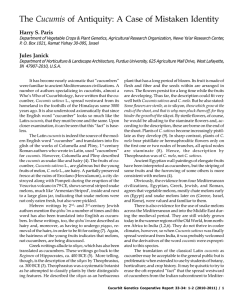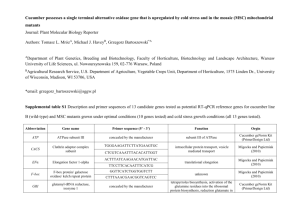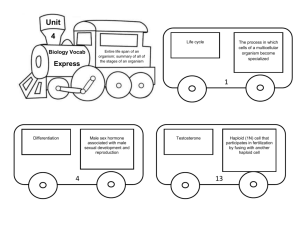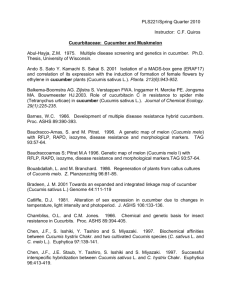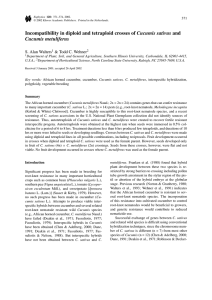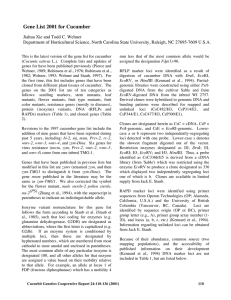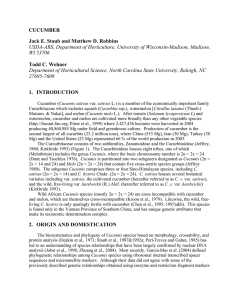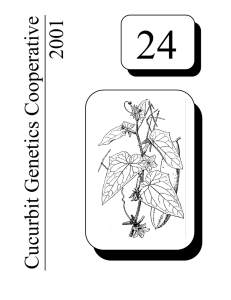Gynogenesis in a Dihaploid Line of Cucumber
advertisement
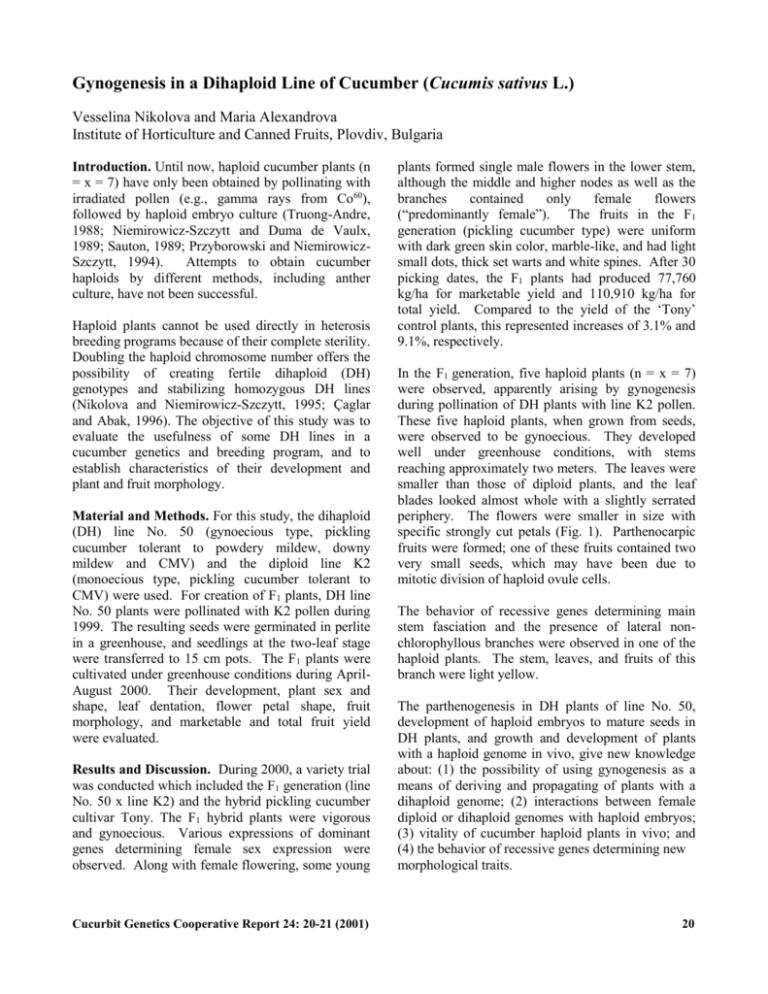
Gynogenesis in a Dihaploid Line of Cucumber (Cucumis sativus L.) Vesselina Nikolova and Maria Alexandrova Institute of Horticulture and Canned Fruits, Plovdiv, Bulgaria Introduction. Until now, haploid cucumber plants (n = x = 7) have only been obtained by pollinating with irradiated pollen (e.g., gamma rays from Co60), followed by haploid embryo culture (Truong-Andre, 1988; Niemirowicz-Szczytt and Duma de Vaulx, 1989; Sauton, 1989; Przyborowski and NiemirowiczSzczytt, 1994). Attempts to obtain cucumber haploids by different methods, including anther culture, have not been successful. Haploid plants cannot be used directly in heterosis breeding programs because of their complete sterility. Doubling the haploid chromosome number offers the possibility of creating fertile dihaploid (DH) genotypes and stabilizing homozygous DH lines (Nikolova and Niemirowicz-Szczytt, 1995; Çaglar and Abak, 1996). The objective of this study was to evaluate the usefulness of some DH lines in a cucumber genetics and breeding program, and to establish characteristics of their development and plant and fruit morphology. Material and Methods. For this study, the dihaploid (DH) line No. 50 (gynoecious type, pickling cucumber tolerant to powdery mildew, downy mildew and CMV) and the diploid line K2 (monoecious type, pickling cucumber tolerant to CMV) were used. For creation of F1 plants, DH line No. 50 plants were pollinated with K2 pollen during 1999. The resulting seeds were germinated in perlite in a greenhouse, and seedlings at the two-leaf stage were transferred to 15 cm pots. The F1 plants were cultivated under greenhouse conditions during AprilAugust 2000. Their development, plant sex and shape, leaf dentation, flower petal shape, fruit morphology, and marketable and total fruit yield were evaluated. plants formed single male flowers in the lower stem, although the middle and higher nodes as well as the branches contained only female flowers (“predominantly female”). The fruits in the F1 generation (pickling cucumber type) were uniform with dark green skin color, marble-like, and had light small dots, thick set warts and white spines. After 30 picking dates, the F1 plants had produced 77,760 kg/ha for marketable yield and 110,910 kg/ha for total yield. Compared to the yield of the ‘Tony’ control plants, this represented increases of 3.1% and 9.1%, respectively. In the F1 generation, five haploid plants (n = x = 7) were observed, apparently arising by gynogenesis during pollination of DH plants with line K2 pollen. These five haploid plants, when grown from seeds, were observed to be gynoecious. They developed well under greenhouse conditions, with stems reaching approximately two meters. The leaves were smaller than those of diploid plants, and the leaf blades looked almost whole with a slightly serrated periphery. The flowers were smaller in size with specific strongly cut petals (Fig. 1). Parthenocarpic fruits were formed; one of these fruits contained two very small seeds, which may have been due to mitotic division of haploid ovule cells. The behavior of recessive genes determining main stem fasciation and the presence of lateral nonchlorophyllous branches were observed in one of the haploid plants. The stem, leaves, and fruits of this branch were light yellow. Results and Discussion. During 2000, a variety trial was conducted which included the F1 generation (line No. 50 x line K2) and the hybrid pickling cucumber cultivar Tony. The F1 hybrid plants were vigorous and gynoecious. Various expressions of dominant genes determining female sex expression were observed. Along with female flowering, some young The parthenogenesis in DH plants of line No. 50, development of haploid embryos to mature seeds in DH plants, and growth and development of plants with a haploid genome in vivo, give new knowledge about: (1) the possibility of using gynogenesis as a means of deriving and propagating of plants with a dihaploid genome; (2) interactions between female diploid or dihaploid genomes with haploid embryos; (3) vitality of cucumber haploid plants in vivo; and (4) the behavior of recessive genes determining new morphological traits. Cucurbit Genetics Cooperative Report 24: 20-21 (2001) 20 Fig. 1. Female flower of a haploid cucumber (Cucumis sativus L.) plant. Literature cited 1. Çaglar G. and K. Abak. 1996. The effects of seasons and irradiation doses on haploid embryo production in cucumber (Cucumis sativus L.). Proc. Fifth Eucarpia Meeting on Cucurbit Genetics and Breeding, Malaga, Spain, 28-30 May 1996, pp. 25-30. 2. Niemirowicz-Szczytt, K. and R. Dumas de Vaulx. 1989. Preliminary data on haploid cucumber (Cucumis sativus L.) induction. Cucurbit Genetics Coop. 12: 24-25. Cucurbit Genetics Cooperative Report 24: 20-21 (2001) 3. Nikolova, V. and K. Niemirowicz-Szczytt. 1995. Evaluation of meiosis in cucumber (Cucumis sativus L.) monohaploids. Caryologia 48: 3-4. 4. Przyborowski, J. and K. Niemirowicz-Szczytt. 1994. Main factor affecting cucumber (Cucumis sativus L.) haploid embryo development and plant characteristics. Plant Breeding 112: 70-75. 5. Sauton, A. 1989. Haploid gynogenesis in Cucumis sativus induced by irradiated pollen. Cucurbit Genetics Coop. 12: 22-23. 6. Truong-Andre, I. 1988. In vitro haploid plants derived from pollination by irradiated pollen on cucumber. Proc. Eucarpia Meeting on Cucurbitacea, France, 143-144. 21

